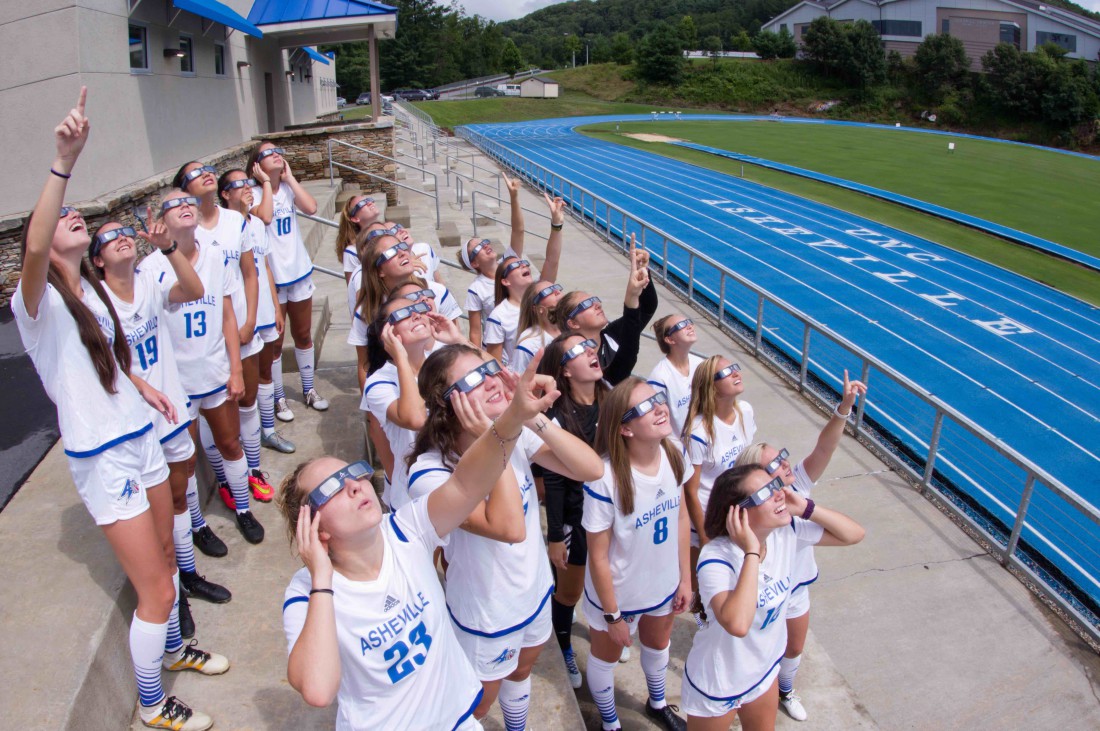Nearly 20 years ago, Amy Sayle of UNC Chapel Hill marked her calendar for Monday, Aug. 21, 2017. The astronomy educator didn’t know where she’d be on that day or exactly what she’d be doing. But one part of her plan was certain: For most of that afternoon, she’d be looking up.
Sayle’s far-off commitment stemmed from the promise of a total solar eclipse, the first in almost a century to pass across the entire continental U.S. “I’ve literally been talking about this eclipse since 1998 — people stopped laughing about a year and a half ago,” she says. On Monday, Ashevilleans can share in the excitement during Asheville’s Solar Eclipse Festival at Pack Square Park, a part of the Carolina Solar Eclipse Parties initiative organized by Sayle and the UNC Morehead Planetarium and Science Center.
The Asheville event is one of more than 50 simultaneous parties being held across the Carolinas. From Fontana Dam in the far west to Folly Beach, S.C., in the southeast, each site offers eclipse glasses for safe viewing and demonstrations for grasping the science behind the show in the sky. “Thanks to funding from the North Carolina Space Grant, we gave all of our partners a full day of training on a kit of 13 hands-on educational activities,” says Sayle. “Just looking at the eclipse is amazing, of course, but we want to help people understand what’s going on and how it works.”
Solar eclipses occur thanks to a convenient cosmic coincidence: Although the sun is roughly 400 times larger in diameter than the moon, it’s also roughly 400 times farther away. When the heavenly bodies align on just the right plane, the moon appears to pass over the sun, darkening the skies until it slips perfectly over the shining disc. Much like a quarter, when held close to the eye, can obscure the view of a much larger light bulb, the tiny moon can block out the massive sun because of its proximity to the Earth.
Observers will see a total eclipse in the approximately 70-mile-wide shadow directly under the moon, known as the umbra. Starting in Oregon, the umbra will move from west to east across the country before passing through the southwest corner of North Carolina and the middle of South Carolina into the Atlantic Ocean. However, Sayle says, a much wider area will be covered by the moon’s penumbra, the lighter shadow in which the sun is partially obscured. “All of North America sees a partial eclipse, and part of South America as well. We’re all getting this,” she says.
Although Asheville lies just outside the path of totality, the moon will still block 99.2 percent of the sun on Monday afternoon. “I don’t think people understand just how long the eclipse will last,” says Cory Van Auken, marketing manager for the Asheville Museum of Science and organizer of the Pack Square Park event. “You’ll be able to see the moon traverse across the sun at around 1:08 p.m., and maximum coverage will be at about 2:36 p.m.,” he says.
When asked what to expect, Van Auken explains the striking scene associated with the eclipse. “With only 1 percent of the sun visible, it’s almost going to look like nighttime, and the temperature will cool by as much as 10 degrees,” he says. “Streetlights will be coming on, and animals will start to act differently.”
Beyond the astronomic phenomenon, Asheville’s Solar Eclipse Festival features food vendors, the Splashville interactive fountain and solar-inspired music curated by DJ Kipper of Mix 96.5. Area science organizations and community groups are also offering a wide variety of eclipse-related family activities. “The National Centers for Environmental Information is actually bringing equipment to monitor temperature and light,” says Van Auken, “while Asheville Yoga is playing off the solar theme by teaching people the sun salutation.” Additional viewing sites are available at Owen, North Buncombe and Roberson high schools for residents who don’t want to venture downtown.
Van Auken adds that safety is crucial when viewing the eclipse. “The darkness will trick you into thinking it’s OK to look up, but even 1 percent of the sun can still really damage the tissue in your eyes,” he says. AMOS is selling eclipse glasses in its gift shop for $1 a pair leading up to the festival and will distribute them for free at the event while supplies last.
Both Van Auken and Sayle hope that the eclipse sparks a wave of wider interest in science and astronomy throughout the Carolinas. After all, says Sayle, “You might as well make friends with the sky. You’re going to be living under it your whole life.”
WHAT: Asheville’s Solar Eclipse Festival, ashevillescience.org/solar-eclipse
WHERE: Pack Square Park, free
WHEN: Monday, Aug. 21, noon-3 p.m. Free




Before you comment
The comments section is here to provide a platform for civil dialogue on the issues we face together as a local community. Xpress is committed to offering this platform for all voices, but when the tone of the discussion gets nasty or strays off topic, we believe many people choose not to participate. Xpress editors are determined to moderate comments to ensure a constructive interchange is maintained. All comments judged not to be in keeping with the spirit of civil discourse will be removed and repeat violators will be banned. See here for our terms of service. Thank you for being part of this effort to promote respectful discussion.